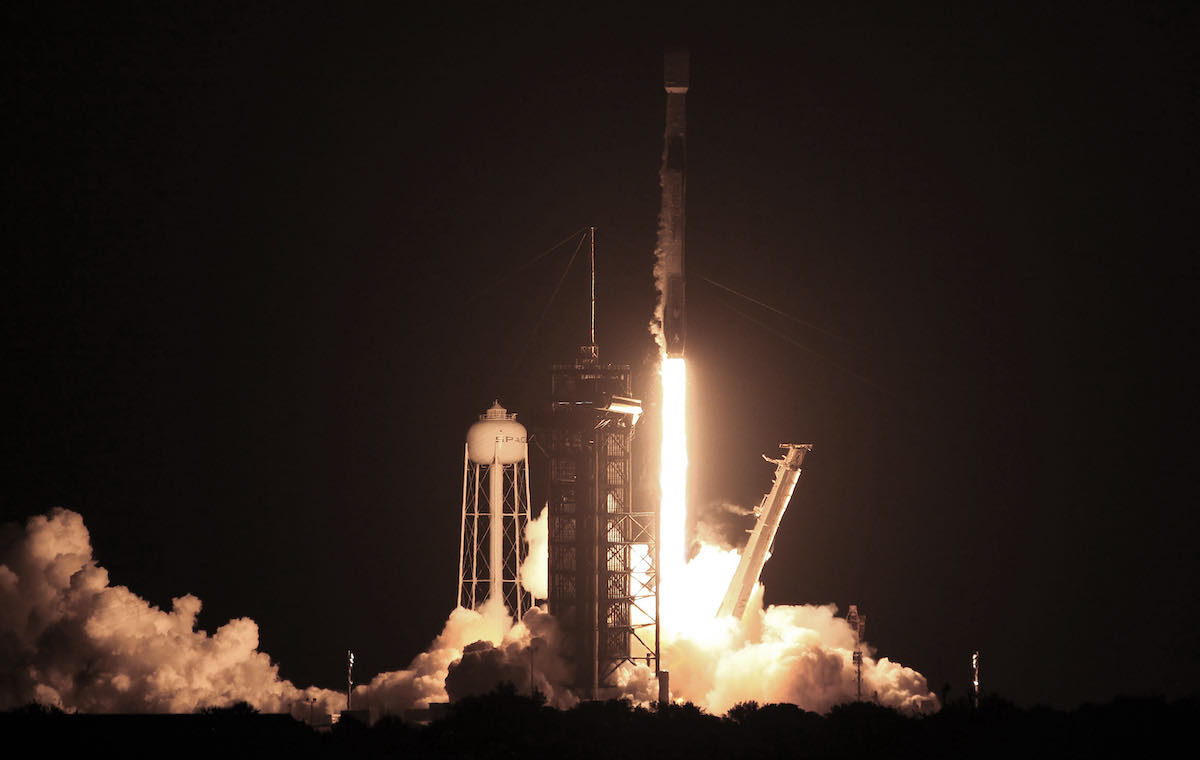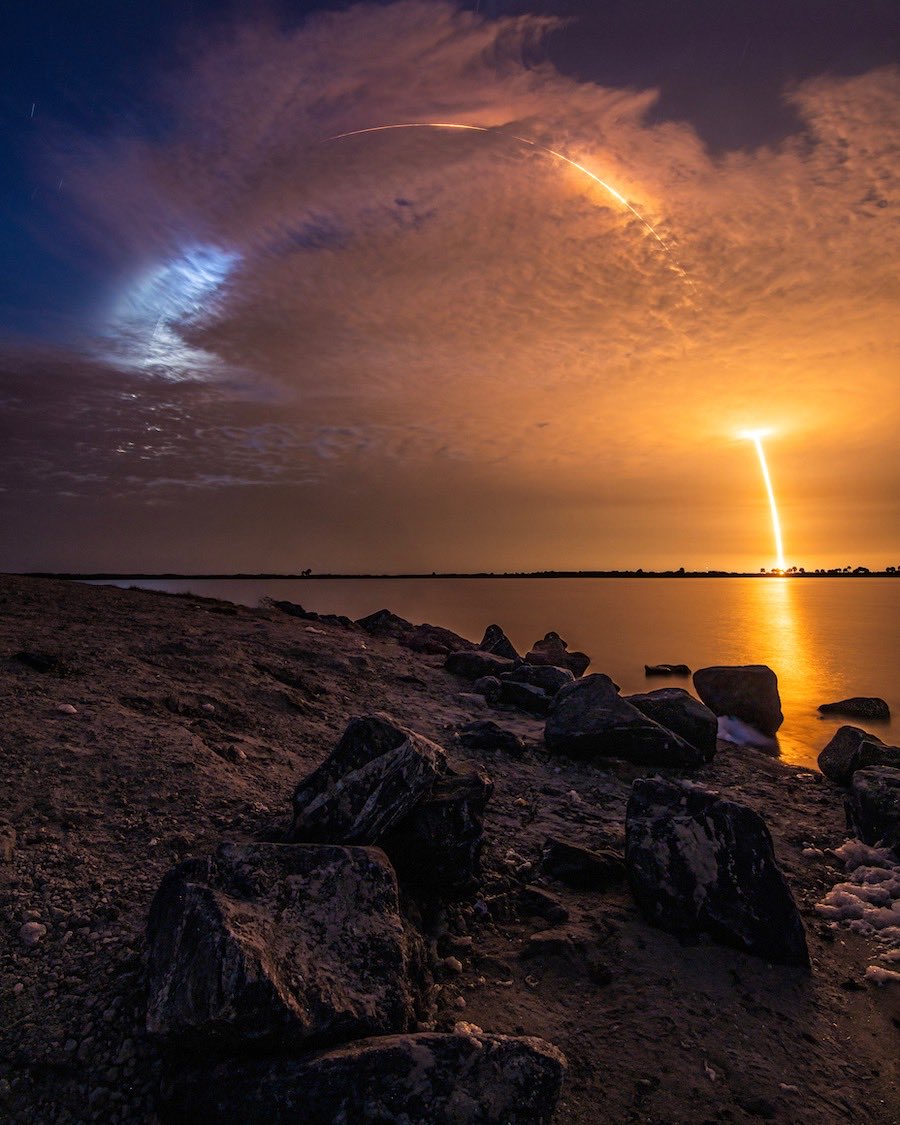Space News & Blog Articles
More Starlink satellites ride into orbit on predawn launch of Falcon 9 rocket
 A Falcon 9 rocket lifts off to begin the Starlink 4-17 mission. Credit: Stephen Clark / Spaceflight Now
A Falcon 9 rocket lifts off to begin the Starlink 4-17 mission. Credit: Stephen Clark / Spaceflight Now
SpaceX launched a Falcon 9 rocket from the Kennedy Space Center at first light Friday with 53 Starlink internet satellites, completing an all-nighter of space operations just five hours after returning four astronauts to a splashdown off the west coast of Florida.
Lighting up the sky over Florida’s Space Coast, a Falcon 9 rocket fired nine Merlin main engines and climbed off pad 39A at Kennedy at 5:42 a.m. EDT (0942 GMT) Friday. SpaceX returned a Dragon capsule to Earth at 12:43 a.m. EDT (0443 GMT), bringing home a crew of four from the International Space Station.
Friday’s launch was the seventh Falcon 9 mission since April 1, a pace near the planned cadence of one launch every five days recently announced by SpaceX founder Elon Musk. SpaceX plans as many as 60 Falcon rocket missions this year from the company’s three operational launch pads.
Two of the April launches carried crews to the space station.
“It’s a pretty special time for us,” said Bill Gerstenmaier, SpaceX’s vice president of build and flight reliability, in a press briefing in the wee hours of Friday morning between the crew splashdown and the Starlink launch.
“I think what’s neat here at SpaceX is we have individual teams that are following all these activities, and they’re focused on their individual piece, and each one of them works on their own area,” Gerstenmaier said. “We still share information across with each other, and that helps us ensure that the spacecraft are safe.
“So when we fly these extra Starlink launches, we actually learn stuff that we can then take and inform the crew flights, and make sure that the Falcon 9s associated with the crew flights are actually better than they would have been if we would not have flown those Starlink flights,” he said.
“I think this is a great time to be in spaceflight, to think we’re poised well as a company to support these multiple activities,” said Gerstenmaier, a former NASA engineer and program manager. “Our heads are not swiveling around. We’re really focused on each individual activity, and we can accomplish them one at a time.”
NASA has a multibillion-dollar contract with SpaceX to provide crew transportation services to the space station. Alongside SpaceX’s commercial launches, NASA engineers have oversight responsibility to ensure the agency’s astronaut missions launch and land safely.
“SpaceX has a tremendous amount of automation in place in terms of data reviews,” said Steve Stich, NASA’s commercial crew program manager. “They can do things quickly. They produce tremendous reports on a launch or a docking operation, then we can take that data and digest it very quickly.
The company also has “attention to detail” and makes sure “we’re doing every operation that requires workmanship and precision, carefully and correctly,” Stich said. “I’ve seen SpaceX stand down and take a timeout at times when maybe they feel like the team needs a break, and needs a little bit of rest.
“And then I’ve seen us make good decisions together, where we need to go in and sometimes you need to do extra work on the vehicle to make it safer. So it’s an exciting time. We’re learning from each flight.”
 SpaceX’s Falcon 9 rocket streaks into the sky over Cape Canaveral, with sunlight illuminating the upper stage exhaust plume. Credit: Michael Cain / Spaceflight Now / Coldlife Photography
SpaceX’s Falcon 9 rocket streaks into the sky over Cape Canaveral, with sunlight illuminating the upper stage exhaust plume. Credit: Michael Cain / Spaceflight Now / Coldlife Photography
The launch Friday morning marked SpaceX’s 152nd Falcon 9 rocket flight, and the company’s 18th launch of the year. It was the 44th SpaceX mission primarily dedicated to launching satellites for the company’s privately-funded Starlink broadband network.
Cloud cover over launch base marred the views for spectators closer to the pad, but the timing of the launch, about an hour before sunrise, yielded spectacular results for skywatchers across other parts of Florida and along the U.S. East Coast as the Falcon 9 climbed into sunlight. The rocket arced toward the northeast from Cape Canaveral to target one of the orbital planes, or pathways, in the Starlink constellation.
The Falcon 9’s first stage, tail number B1058 in SpaceX’s inventory, shut down about two-and-a-half minutes after liftoff to begin a descent toward the company’s drone ship “A Shortfall of Gravitas” parked a few hundred miles downrange in the Atlantic Ocean.
The propulsive landing occurred about eight-and-a-half minutes after liftoff, moments before the Falcon 9’s second stage engine completed its first firing to place the 53 Starlink satellites into a parking orbit. The booster stage became the third in SpaceX’s fleet to fly 12 times, the current record for Falcon 9 stages.
This booster debuted in May 2020 with the launch of the first test flight of SpaceX’s Dragon spacecraft to carry astronauts. With Friday morning’s launch, the booster has helped haul 637 satellites and two people into space/.
The Falcon 9 reignited the upper stage’s Merlin-Vacuum engine about 45 minutes into the mission, setting the stage for separation of the 53 Starlink satellites at T+plus 54 minutes, 30 seconds. SpaceX confirmed a good deployment of the payloads.
Retention rods holding the satellites into a flat-packed configuration on the rocket jettisoned, allowing the Starlink platforms to fly away from the second stage. They will unfurl solar arrays and run through automated activation steps, then use krypton-fueled ion engines to maneuver into their operational orbit.
The Falcon 9 aimed to deploy the satellites in a near-circular orbit ranging in altitude between 189 miles and 197 miles (304 by 317 kilometers), at an orbital inclination of 53.2 degrees to the equator. The satellites will use on-board propulsion to do the rest of the work to reach a circular orbit 335 miles (540 kilometers) above Earth.
The Starlink satellites on Friday’s mission will fly in one of five orbital “shells” used in SpaceX’s global internet network. After climbing into their operational orbit, the satellites will enter commercial service and begin beaming broadband signals to consumers, who can purchase Starlink service and connect to the network with a SpaceX-supplied ground terminal.
After Friday’s launch, designated Starlink 4-17, SpaceX has deployed 2,494 Starlink satellites in orbit, including spacecraft that were decommissioned or suffered failures. More than 2,100 of those satellites are in orbit and functioning as of this week, according to a list maintained by Jonathan McDowell, an astrophysicist who tracks spaceflight activity.
That makes the Starlink fleet the largest satellite constellation in the world, by a factor of nearly five over the internet satellite fleet owned by rival OneWeb.
SpaceX is in the midst of launching some 4,400 Starlink satellites into the network’s five orbital shells. The first of the five shells was filled last year, and SpaceX is expected to begin launching into additional shells later this year. All of the orbits are located between 335 and 350 miles above Earth, while some are in mid-inclination orbits — like the orbit targeted on Friday’s mission — and others are in polar orbits.
SpaceX’s next Falcon 9 launch, also carrying Starlink internet satellites, is scheduled for Tuesday, May 10, from Vandenberg Space Force Base, California.
This email address is being protected from spambots. You need JavaScript enabled to view it. the author.
Follow Stephen Clark on Twitter: @StephenClark1.
When you subscribe to the SpaceZE News Feed, we will send you an e-mail when there are new updates on the site so you wouldn't miss them.

